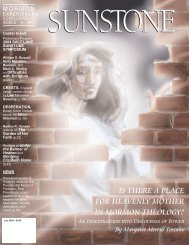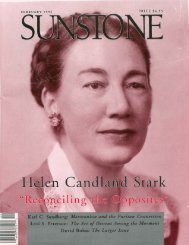00a_cover cmyk dark blue.qxp - Sunstone Magazine
00a_cover cmyk dark blue.qxp - Sunstone Magazine
00a_cover cmyk dark blue.qxp - Sunstone Magazine
Create successful ePaper yourself
Turn your PDF publications into a flip-book with our unique Google optimized e-Paper software.
S U N S T O N E<br />
other faiths live theirs. The Backslider reflects<br />
LDS culture as it really is, not as we wish it<br />
were. And this is why we should read this<br />
book. Instead of being subversive of Church<br />
values, it shows us the foolishness of our<br />
own inconsistency in applying Christian<br />
principles in our lives. Recognizing our own<br />
foibles through fiction might help us accept<br />
and tolerate not only our own shortcomings<br />
but also those of others. Acceptance and tolerance—that<br />
sounds like the basis of the<br />
Golden Rule. What could be more supportive<br />
of Church values?<br />
ANN M. JOHNSON<br />
Cedar City, Utah<br />
A USEFUL MEDITATION<br />
PHILIP MCLEMORE’S TAKE ON<br />
President McKay’s thoughts about meditation,<br />
together with his own personal observations<br />
and practices, certainly gives a new<br />
meaning (for LDS, at least) to the word<br />
“mantras” and how they pertain to our individual<br />
lives (SUNSTONE, April 2006). After<br />
reading the article carefully several times,<br />
and with a bit of meditation on my own, I<br />
would be hard pressed to endorse the practice<br />
as he portrays it.<br />
It would be interesting to have President<br />
McKay enlarge on his concept of meditation<br />
and the pondering of sacred things. I have<br />
personally heard his counsel on our need to<br />
study, ponder, and ask for the promise of<br />
Moroni to be realized in all areas of our lives.<br />
Other than that aspect, I would be hard up to<br />
quote any past or present prophet who has<br />
endorsed meditation.<br />
Rather than McLemore’s type of practice, I<br />
would suggest an alternate plan. Let’s call it<br />
the “temple mantra.” Instead of emptying our<br />
minds and thus becoming an inert and useless<br />
person, would it not be better to spend<br />
twenty minutes or so meditating upon the<br />
sacred truths of the temple endowment? This<br />
practice would, in addition to expanding our<br />
minds spiritually, mentally, and physically,<br />
enable us to offer the same gift to others.<br />
Doing so is often referred to as becoming<br />
a Savior on Mt. Zion.<br />
MAX H. RAMMELL<br />
Bountiful, Utah<br />
OVERSTATED PRAISE<br />
Boast not . . . for thou knowest not what a<br />
day may bring forth. PROVERBS 27:1<br />
G<br />
ERRY ENSLEY’S TRIUMPHAL<br />
assessment of Blake Ostler’s twopart<br />
essay dealing with the logic of DNA<br />
arguments against Book of Mormon historicity<br />
and exchanges with some of his<br />
critics (Letters, SUNSTONE, April 2006)<br />
is not conducive to open dialogue, not to<br />
mention dreadfully misinformed and<br />
premature. All but one of Ostler’s responses<br />
were to criticisms of his first essay,<br />
which were also premature, for the<br />
validity of Ostler’s critique of DNA arguments<br />
depends a great deal on the validity<br />
of his defense of the local<br />
colonization theory in his second essay,<br />
which, to quote David A. Anderson, was<br />
“wholly unsuccessful” (Letters, SUN-<br />
STONE, September 2005). Anderson’s<br />
critique exposed some of Ostler’s faulty<br />
assumptions, logical lapses, and textual<br />
manipulations. Ostler responded, to be sure,<br />
but despite Ensley’s assertion, it was not<br />
“well-reasoned.”<br />
Ostler may have scored some points early<br />
in the exchanges, but he was beginning to<br />
lose ground and credibility when the discussion<br />
was pushed out of the limelight and into<br />
the outer-<strong>dark</strong>ness of <strong>Sunstone</strong>blog.com (see<br />
announcement, SUNSTONE, November<br />
2005, 7). There, at the top of the “Book of<br />
Mormon Historicity” thread, one can find my<br />
response to Ostler’s second essay, which I<br />
recommend Ensley read (after he rereads<br />
Anderson’s critique) and carefully contemplate.<br />
While Ensley asserts that critics have used<br />
“fraudulent arguments” that rest on “problematic<br />
foundations,” he should consider the<br />
fact that critics have formulated their arguments<br />
based on the views and interpretations<br />
held by a majority of the LDS community,<br />
which apologists have yet to convincingly<br />
demonstrate are wrong (which is different<br />
than showing that they are unrealistic). The<br />
critics are well aware of apologetic inventions<br />
such as the limited geography and local colonization<br />
theories; they just don’t buy them<br />
and believe that many LDS, once informed of<br />
the issues, won’t either. If DNA arguments<br />
are “fraudulent” and “problematic” because<br />
they assume the traditional view and reject<br />
SUNSTONE welcomes<br />
a new cartoonist to<br />
its pages, Jonathan<br />
David Clark. Jon is a<br />
Latter-day Saint who<br />
lives in Knoxville,<br />
Tennessee, with his wife<br />
and four children. He’s<br />
a full-time music composer for television and<br />
a part-time cartoonist whose strip, “Honest<br />
Jon,” is syndicated in eight newspapers and<br />
three magazines.<br />
JONATHAN DAVID CLARK<br />
SEPTEMBER 2006 PAGE 3

















